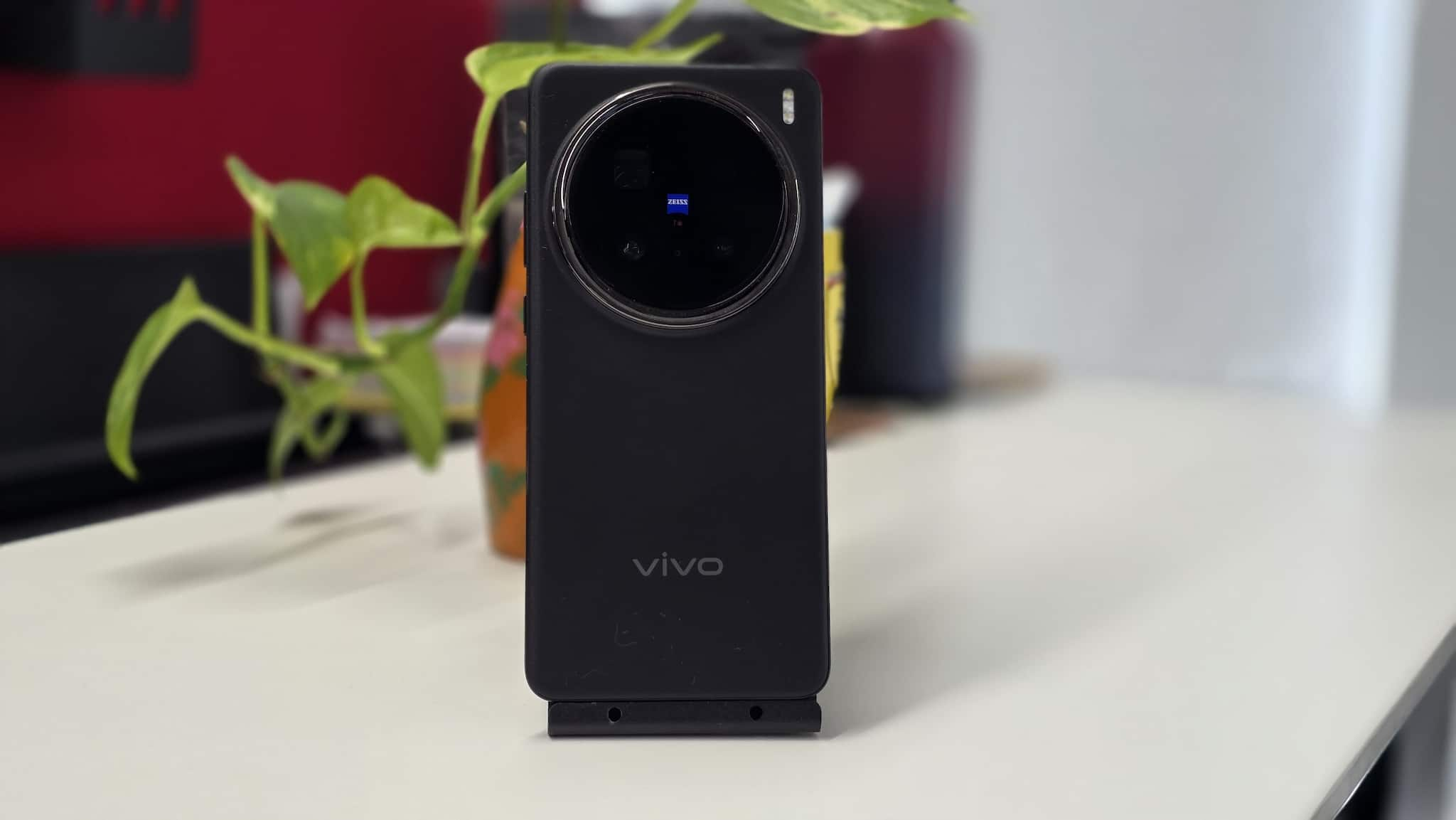
Rating: 8.5/10 It's one thing to say that smartphone cameras have come a long way. It has actually, so much so that they can put some mid-range DSLRs, to shame.
Then there’s the Vivo X200 Pro, a smartphone with the calibre to match even flagship DSLRs. That’s a big claim to make. However, there are a few aspects of the X200 Pro that offer a DSLR level of output when it comes to the camera.

And, how can one forget the long-running ZEISS partnership? It's there in X200 Pro as well and it is even better here than all the other X series phones come so far. And as far as features are concerned, there’s no shortage there as well. The X200 Pro is powered by a MediaTek Dimensity 9400 chip, features both IP68 and IP69 ratings, has a curved AMOLED display, and has a 6000mAh battery.
Plus, the phone is priced at Rs 94,999. Now, the phone might feel a little expensive, but that price tag brings a host of things, especially when it comes to the camera capabilities. The question here is whether the phone is good enough and has that ‘X’ factor, or if it is an overpriced proposition.
I have used the X200 Pro for almost a month and here is my detailed review Vivo X200 Pro review: Camera If you’ve made till here then you must have read “a smartphone with the calibre to shame even flagship DSLRs” and that’s a bold statement to make and many hardcore photographers might disagree with this. Nonetheless, it does not make the X200 Pro any less capable than it is. And that makes it more important to talk about the X200 Pro’s camera quality before everything else and why not, Vivo has always touted the X series phones as their most powerful camera phone.
X200 Pro Camera The X200 Pro comes with an all-new 200MP telephoto sensor with OIS support and 3.7x optical zoom, a primary 50MP OIS Sony LYT 818 sensor, a 50MP wide-angle AF sensor, and a 32MP front camera with fixed focus. X200 Pro Camera Sample But, that’s not the interesting part here.
The primary 50MP sensor has an f/1.57 aperture which is one of the best you can find in any smartphone. Moreover, the rear flash has a colour temperature sensor.
X200 Pro Camera Sample As always, Vivo has packed the X200 Pro with tons of shooting modes: Landscape, Photo, Video, High Resolution, Ultra HD Document, Time-lapse, pro, Portrait, Portrait Video, Stage, pano, Snapshot, Supermoon, astronomy, Night, Super Macro, and ZEISS Multifocal Portrait. X200 Pro Camera Sample In addition to these, there’s the dedicated V3+ chip that enhances the image processing and also makes them faster than other flagship phones out there. In my experience, the combination of two chips makes the image processing much faster and you can notice it with the shutter speed it has and the time it takes to process them.
There’s no processing time between the photos and that’s something other Android manufacturers should also try and implement in their flagship phones. X200 Pro Camera Sample But what about the image quality? First, the trio of the X200 Pro’s camera setup, Ziess algorithm, and V3+ chip do an impressive job here. Whether you are capturing photos in daylight or low-light conditions, the phone manages to retain plenty of details, sharpness, and dynamic range.
Plus, the real-time image processing is the cherry on top. Also, the camera delivers consistent results with every single click. X200 Pro Camera Sample Well, how can I forget the all-new Landscape mode which is not only a dedicated Landscape mode, but also integrates a couple of other modes into it like Night mode? Well, as part of night mode, you still get the night mode – an automatic one with the Photo mode.
X200 Pro Camera Sample X200 Pro Camera Sample Coming back to the point, I also liked what Vivo has done with the focal length setup of the X200 Pro, especially the 3.7x zoom (85mm) setup of the 200MP telephoto lens. There’s a 135mm ‘super close-up’ mode too that usually photographers use to capture the impressive depth of field and that intense nature with true lines.
The icing on the cake is the focus distance which is shorter for the kind of zoom levels the phone has to offer. This makes X200 Pro a perfect camera for capturing a wide range of photos, such as food and close-up shots. Vivo has also managed to keep the dynamic range of the zoom lens intact with minimal noise and accurate white balance.
Let’s talk about image processing. The phone processes images without overdoing it. The overall processing is natural.
There’s a little bit of extra sharpening, but it does not make the photos feel overprocessed or too HDR-ish. Whatever the case is, the image processing does make the photos look beautiful and pleasant to the eyes. The X200 Pro delivers impressive shots in portraits as well.
The background defocus is realistic, and Vivo’s post-shot adjustment options enable users to fine-tune the blur for a more natural depth of field. Even for dynamic scenes, such as a subject throwing leaves, the camera captures precise focus with convincing background separation. X200 Pro Camera Sample Zooming beyond 10x reveals Vivo’s computational photography strengths, cleaning up details in landscapes and objects.
However, it struggles slightly with text and faces at extreme zoom levels, but that’s kind of acceptable and we anyway aren’t expecting a phone to deliver 120x zoom shots with additional processing. X200 Pro Camera Sample Then there’s the updated Super Landscape mode, which delivers impressive shots without compromising on quality. It captures the clear moon while keeping the details in the surroundings intact, and that’s beyond impressive.
I haven’t seen any other phone pull that shot this effectively. Video performance is another highlight. The X200 Pro supports 4K 120fps and Dolby Vision HDR10 capture across all rear cameras and introduces LOG video recording with downloadable LUTs.
The 85mm telephoto camera produces DSLR-grade video in bright settings, with rich colours and sharp details. The lowlight video frame rate is even steadier than most phones, so the phone qualifies for professional-grade video output, too. Vivo X200 Pro review: Performance When it comes to performance there are certain things that Vivo has done and I call them a bold move.
Now, if you see other Android flagship phones in this price range, most of them opt for Qualcomm’s latest. However, the X200 Pro is powered by Dimensity 9400 chip, the flagship and most powerful chip from MediaTek. X200 Pro I have used this chip in other smartphones like the Oppo Find X8 series and if you’ve read that review, you already know that the chip can handle things without breaking a sweat.
Talking about the chip, it has a 3nm process and has eight cores (1 × Cortex-X925 (3.626 GHz) + 3 × Cortex-X4 (3.3 GHz) + 4 × Cortex-A720 (2.
4 Ghz)) The performance of the Vivo X200 Pro is no different. The phone handles lightweight tasks without any issues. Day-to-day stuff like browsing, listening to music, watching content and even social media stuff runs without any issues.
The multitasking performance is also on par with the competition, thanks to the 16GB RAM onboard. X200 Pro Moving on to resource-hungry tasks like photo and video editing, running CPU-intensive applications, and even AI processing works just fine here. I tried editing some photos using Photoshop and the built-in editor, and the phone managed them all and processed all the layers and edits from Photoshop in a blink.
The same was the case with video editing, except for the blink part, as rendering and exporting videos take a while. So, no complaints in that department. Let’s talk gaming.
Being a gamer, I tried playing a couple of titles such as CoD Mobile, Genshin Impact, BGMI and even some lightweight titles Subway Surfer, Candy Crush, etc. Lightweight titles – no issues at all. Heavy games like CoD and Genshin Impact – also no problem even at maxed-out graphic settings.
X200 Pro Next up is the software. The phone comes with FunTouch OS 15 based on Android 15 and not to mention, the software is way more refined than it ever was. Perhaps, this is the most improved version of FunTouch OS I have seen in years of the update.
The animations are much smoother and refined. They are streamlined too and this applies across the user interface and not just a couple of places. Other than this, the icons and user interface now feel more rounded and modern.
FunTouch OS 15 is more colourful and more customisable as well. You can choose from multiple widgets, icons, screen on and off animations, call screens and much more. If you are someone who loves to customise their phone as per your liking and preference, then the FunTouch OS 15 has got you covered.
But that’s not it, the customisation options go beyond the appearance part. There are tiny little things within the FunTouch OS 5.0 that can make this review easily reach 5000 words.
But, I’ll keep it short and simple – you can choose if you want to share unlimited data via hotspot or just 50MB, and then there’s the Custom brightness feature that makes adaptive brightness far superior to what we’ve seen from other brands. Things do not end here. Vivo has also added a couple of AI features, like AI Photo Enhance, AI Erase, Live Call translation, Gemini Assistant, and Circle to Search.
I used AI Photo Enhance, and to my surprise, it worked pretty well. It can improve old photos and modernise them in a way you won’t even realise. Next, the AI Photo Erase works just fine here.
It needs a little more polish, though. I also tried the Live Call Translation feature, and like Photo Erase, it feels like a first-generation implementation that will improve over time. Vivo X200 Pro: Design and display Vivo X200 Pro is Vivo’s non-foldable flagship smartphone and it should feel like one too.
And, it does have that premium look and feel to it. The matte finish back panel with chunky circular camera housing with a chrome ring around it makes the phone feel substantial. The side rails are wide enough to offer a good grip.
However, the camera housing does make the phone feel a little top-heavy. X200 Pro The right side of the phone has the power and volume rocker and the left side of the phone is clean with two visible antenna bands. The bottom of the phone has a USB Type-C port along with the primary microphone, speaker and SIM tray.
The top has a secondary microphone and two antenna bands. Talking about the display, the phone features a 6.78-inch 1.
5k+ resolution, 120Hz refresh rate AMOLED panel. The display quality is top-notch with vivid colours, deep blacks and crisp text. The brightness max out at 4500nits and that’s more than enough for almost everything.
Also, the display gets dim enough to make your bedtime usage comfortable for your eyes. Verdict I have reviewed and used several versions of X-series phones and with every generation things have become better and better as if Vivo always has some party trick ready for its next generation. The X200 Pro is by far the most improved phone in the lineup.
The camera update – especially that new 200MP telephoto lens takes the camera experience in flagships to another level and as a whole, the entire setup delivers on all fronts – it does not matter what kind of photos or videos you are planning to capture. The performance, display, battery and all other things are just on point and there’s nothing much to complain about. All-in-all, if your requirement is about the camera performance, the search ends right here.
And, even if you are looking for a premium phone that delivers on all fronts, then the X200 Pro should be in your top 5 list..















